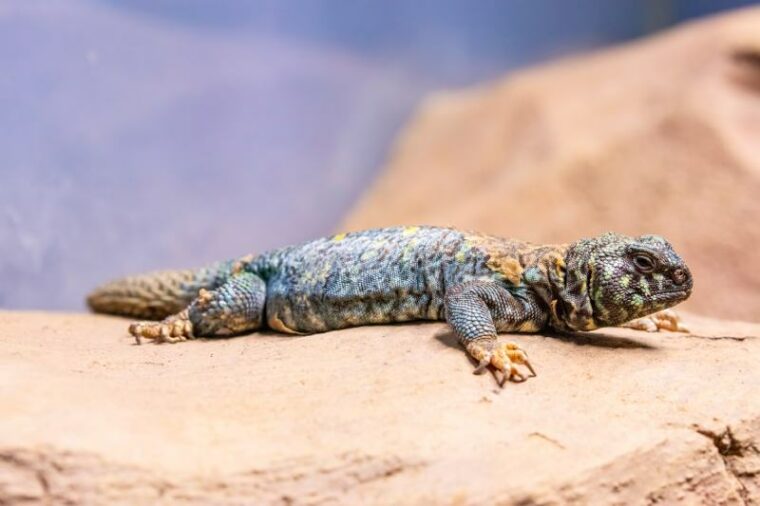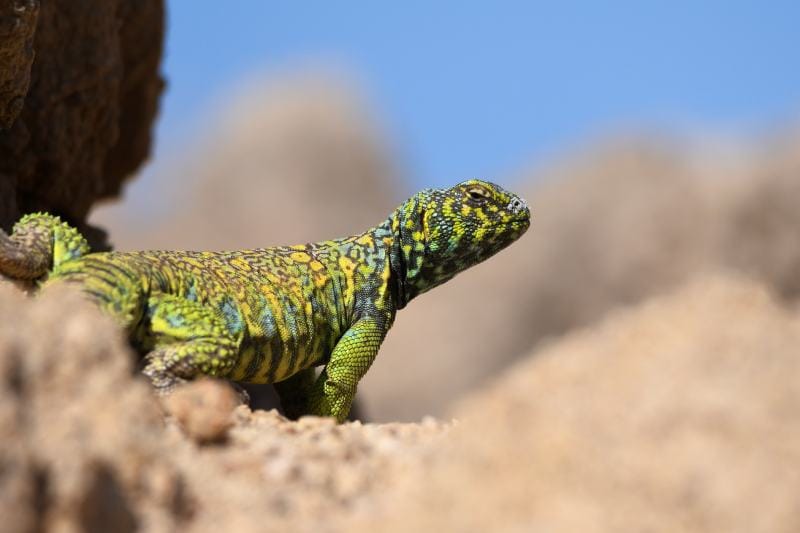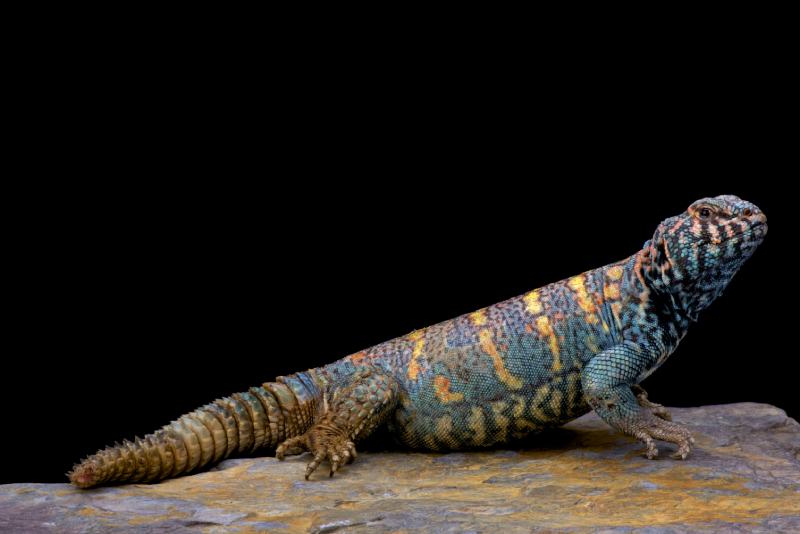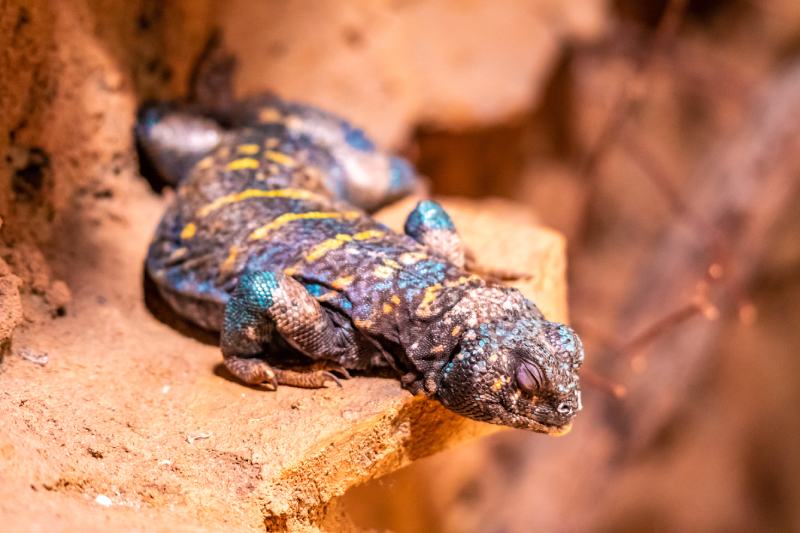
The Uromastyx, more commonly known as the spiny-tailed lizard, is a herbivorous reptile native to Africa and Asia. It is not a great pet for beginner reptile keepers, thanks to its particularly difficult temperature, heating, and lighting requirements. But, if you have experience with reptiles and are looking for a unique and cool pet, the Uromastyx may fit the bill.
Read on to learn more about this reptile, including everything you need to know about its challenging husbandry requirements.
Quick Facts about Uromastyx
| Species Name: | Uromastyx |
| Common Name: | Spiny-tailed lizards |
| Care Level: | Advanced |
| Lifespan: | 10 to 20 years |
| Adult Size: | Up to 30 inches |
| Diet: | Primarily herbivorous |
| Minimum Tank Size: | 48”L x 24”W x 24”H |
| Temperature & Humidity: | 80 – 120°F; 35% humidity |
Does the Uromastyx Make a Good Pet?
Uromastyxs can be fantastic pets for advanced reptile keepers. They are active during the daytime and simple enough to feed and care for. Some species are quite shy, and it’s not unusual for them to hide whenever you try to handle them. Others are unafraid of humans entirely.

Appearance
Though Uromastyxs come in various shapes and sizes, all species share several key physical traits. They all have bulky bodies, triangular-shaped heads, and spiny tails. Their tails have anywhere between 10 and 30 rows of spiky scales.
The skin color in some species will change if the reptile is stressed or experiencing certain temperature shifts. When they’re warm, the body will change to a pale brown with orange patches, while the tail becomes an azure blue. In periods of extreme heat, the reptile changes to an almost white appearance.
Hatchlings typically measure between three and four inches. Full-grown Uromastyx can be between 10 to 18 inches long, though certain species (e.g., Egyptian Uromastyx) can go to be 30 inches.
How to Take Care of Uromastyx
Habitat, Tank Conditions & Setup
Tank
The minimum tank size for an adult Uromastyx is 48”L x 24”W x 24”H; however, the more space you can provide your reptile, the better. They need plenty of space to move around, and you need enough area in the enclosure to achieve a temperature gradient (more about proper temps later).
Lighting
You’ll need an overhead light source to maintain optimal temperatures in your pet’s tank. Reptile basking lights are recommended as they’re designed specifically for this purpose.
UVB lighting will also need to be provided. We recommend using a UVB bulb that is half the length of your reptile’s enclosure. It should be placed on the warm side and in a reflective T5 fixture.
When considering lighting placement, you must determine whether you’ll place the fixtures on top of your tank’s mesh roof or inside the enclosure. If you’re mounting the UVB bulb over the mesh, it should be approximately 8 to 13 inches above your Uromastyx’s back when he is basking. It must be 14 to 20 inches above the back if it goes under the mesh. You can also use a Solarmeter to help you determine where the best bulb placement is for your particular setup.
Your Uromastyx will also benefit from bright white light in his enclosure. Choose a bulb with a color temperature of approximately 6,500K to promote optimal mental and physical well-being.

Heating (Temperature & Humidity)
As a cold-blooded creature, your Uromastyx relies heavily on his environment to regulate his body temperature. This is where you come in. A halogen heat lamp is most often recommended as a heat source.
Your pet’s enclosure needs a basking area that allows for daytime temperatures of around 120°F, but his entire tank shouldn’t be this temperature. This is why getting the biggest enclosure possible is important to allow for a proper gradient, as your reptile will self-regulate his temperature by moving from one end of his tank to the other when necessary.
The ambient temperature should be around 100°F on the “warm” side, while the “cool” side should be in the 80–85°F range. Heat sources should be turned off at night to stimulate your pet’s natural environment. They can tolerate temperatures as low as the upper 60s.
Most Uromastyx don’t tolerate high humidity levels well. The enclosure should therefore be below 35% humidity (preferably 20% to 30%) at all times. You must invest in a reliable hygrometer to keep tabs on these levels.
That said, Uromastyx enjoy having access to a humid “burrow”. They will often dig one out for themselves from their substrate, but you may need to add a bit of water to help prevent the burrow from collapsing.
Substrate
Uromastyxs are healthiest and happiest when kept in an enclosure filled with substrate they’d encounter in their natural habitat. Their habitat is sand or sandy soil, so keep that in mind when picking the substrate for your tank. Buy enough substrate to pack four inches deep, though if you can go deeper, we highly recommend it. If you take our advice and use a 48”L x 24”W x 24”H enclosure, you’ll need approximately 2.5 cubic feet of substrate.
Tank Recommendations
| Tank Type | 48”L x 24”W x 24”H enclosure |
| Lighting | UVB & bright white light |
| Heating | Halogen heat lamp |
| Best Substrate | Sand or sandy soil |
Feeding Your Uromastyx

Uromastyx are herbivores, surviving on an entirely plant-based diet. Most of their diet should consist of various nutritious veggies like collard greens, arugula, dandelion greens, Bok choy, endives, and spring mix. Uromastyxs also require seeds like lentils once a week and can eat edible flowers like hibiscus and clover and fruits like apples and papaya as special treats.
As with many reptile species, calcium and multivitamin powders are recommended to ensure your pet is getting his nutritional needs met.
How often and how much you feed your reptile will depend on his age. A juvenile should be given a meal daily and allowed to eat as much as possible, while an adult should be fed four or five times a week.
Diet Summary
| Vegetables | 90% |
| Fruits and edible flowers | 5% |
| Seeds | 5% |
| Supplements Required | Calcium powder, multivitamin powder |
Keeping Your Uromastyx Healthy
The biggest issue with keeping any reptile healthy is ensuring your husbandry is 100%. You must provide the exact environment your Uromastyx needs to thrive by nailing his lighting, heating, and temperatures.
Some species, especially the Oromastyx ornatus, are highly fragile in the first few weeks of life. They have a high mortality rate and require special care and attention during their first two months. Most believe this fragility comes from difficulties acclimating to the climate in captivity. This breed lives in the extreme desert in steep, rocky valleys, and ravines, so it’s up to you to recreate this habitat for them as best you can.

Common Health Issues
Respiratory conditions. Things like breathing issues are often caused by improper husbandry, like unsuitable temperatures and wrong humidity levels. These conditions can sometimes cause fatal infections, so you must be familiar with proper husbandry well before you bring your Uromastyx home.
Bacterial infections. Any lumps or bumps on your reptile’s skin or joints should be investigated by your exotic veterinarian as soon as possible. Such signs could indicate a bacteria infection, gout, or hyperparathyroidism.
Gastrointestinal conditions. Signs like watery poop and vomiting commonly indicate a gastrointestinal disease. These can be caused by poor nutrition and other infections.
Nutrient deficiency. Improper UVB lighting can cause nutritional deficiencies and may lead to various health conditions, such as body disfigurement and broken limbs.
Lifespan
Most Uromastyx species live between 15 and 20 years; however, this isn’t true of all species. The Egyptian Uromastyx, for example, has the longest lifespan of up to 30 years. With proper husbandry, healthy specimens can live beyond that 30-year mark.
Breeding
Uromastyxs are slow growers and take quite some time before they reach sexual maturity. Most are sexually mature between ages three and four, though some may take up to five years to be ready to breed.
Wild Uromastyxs will brumate during the cooler months and then become active and interested in breeding during early spring. Give them two weeks to fully recover from brumation, and ensure your husbandry is 100% on point. If your female has lost weight, focus on feeding her a nutritionally complete diet and getting her back to her usual weight before breeding.
Do not mix different species, as the resulting babies may not survive, and those that do can develop serious, debilitating health issues.
Supervise the male and female when they are together the first few times. If you see them fighting, separate them immediately and try again later.
Female Uromastyx lay between 5 and 40 eggs, depending on their age and species. The eggs are laid approximately 30 days after copulation and require a 70- to 80-day incubation time.
Is the Uromastyx Friendly? Our Handling Advice

Most Uromastyxs are shy, though they can get used to being handled if their keepers are patient. Gentle handling and moving slowly around them are very important while building a relationship with your lizard.
As with any reptile, you’ll need to build trust with your Uromastyx before you can expect to handle them. When you first bring him home, leave him alone for a few weeks to give him time to settle in.
Hand feeding is a great trust-building activity. Once he willingly takes food from you, encourage him to climb into your hand by placing his food onto your arm so he has to climb up to get it.
The more interaction you make time for, the faster your reptile will start trusting you.
Shedding & Brumation: What to Expect
Shedding is a normal process that reptiles go through to replace their old skin with new skin. It occurs more often in younger reptiles as they’re still growing, but adults will still shed annually. You’ll know your pet is about to shed when his skin becomes duller. He may also exhibit behavioral signs such as sleeping or hiding more than usual.
Brumation is a condition of inactivity exhibited by reptiles during extended periods of low temperatures. It occurs during winter and can last as long as four months. Your reptile must be in good health and disease-free before going into brumation. Uromastyx in brumation will exhibit signs such as:
How Much Does a Uromastyx Cost?

Uromastyx adoption fees can vary greatly by species. You can pay as little as $80 to adopt a baby Yellow Uromastyx, while an adult Egyptian Uromastyx can run you anywhere between $200 and $550. We even found online retailers selling rarer species for as much as $1,000. So, as you can see, the price will vary wildly from breeder to breeder and species to species.
Care Guide Summary
Conclusion
Uromastyxs are a unique pet suitable for experienced reptile keepers. While they’re relatively easy and cheap to feed, their particular temperature, heating, and lighting requirements can make them difficult to keep as pets. Additionally, they’re not as friendly and docile as other reptile species right out of the gate, making their keepers need to work to earn their trust and respect.
Featured Image Credit: Danny Ye, Shutterstock








